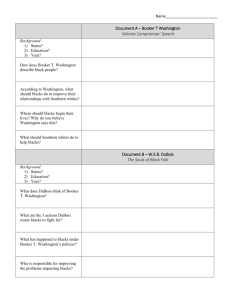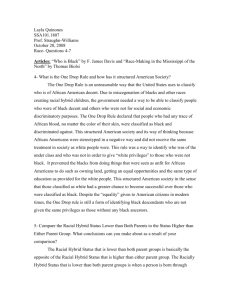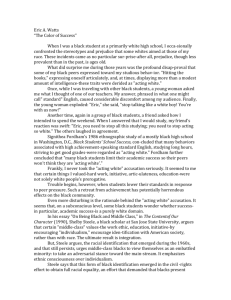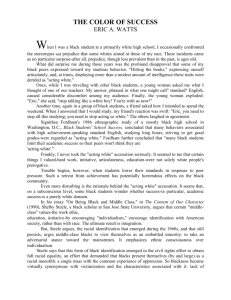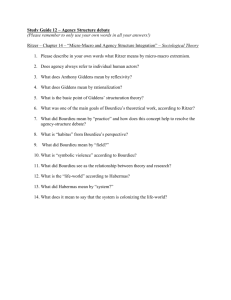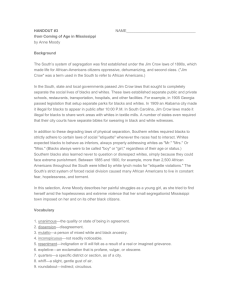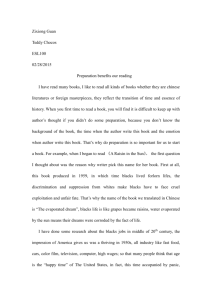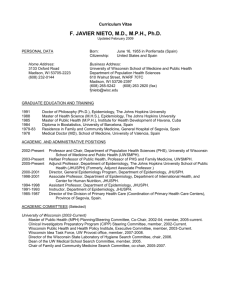Class notes
advertisement
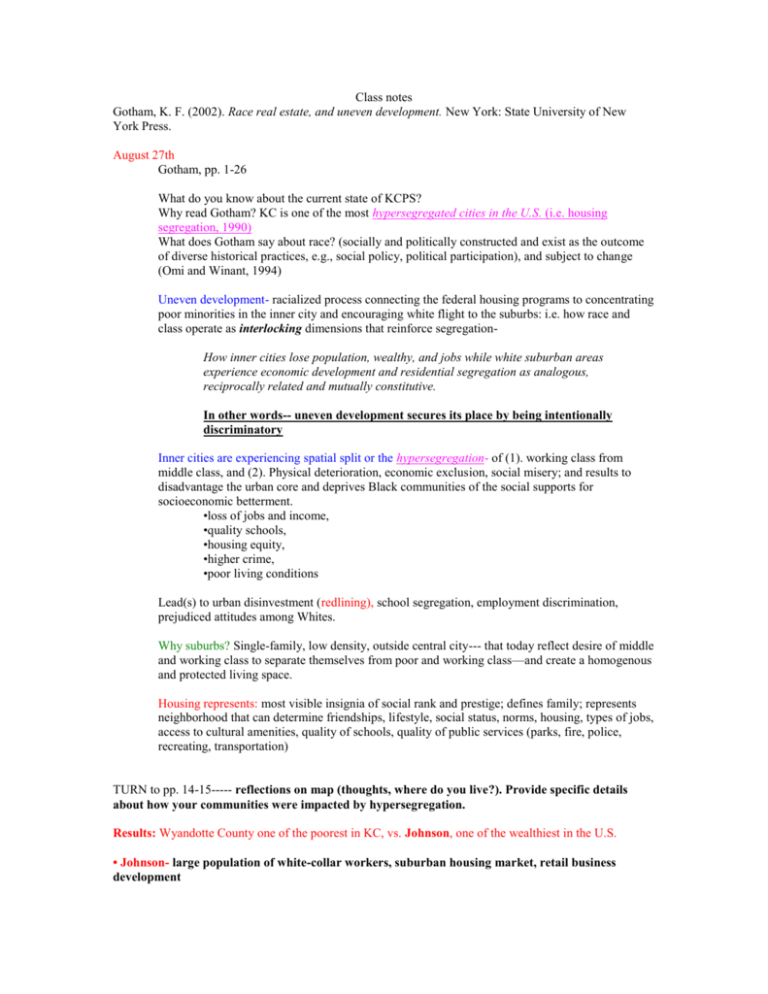
Class notes Gotham, K. F. (2002). Race real estate, and uneven development. New York: State University of New York Press. August 27th Gotham, pp. 1-26 What do you know about the current state of KCPS? Why read Gotham? KC is one of the most hypersegregated cities in the U.S. (i.e. housing segregation, 1990) What does Gotham say about race? (socially and politically constructed and exist as the outcome of diverse historical practices, e.g., social policy, political participation), and subject to change (Omi and Winant, 1994) Uneven development- racialized process connecting the federal housing programs to concentrating poor minorities in the inner city and encouraging white flight to the suburbs: i.e. how race and class operate as interlocking dimensions that reinforce segregationHow inner cities lose population, wealthy, and jobs while white suburban areas experience economic development and residential segregation as analogous, reciprocally related and mutually constitutive. In other words-- uneven development secures its place by being intentionally discriminatory Inner cities are experiencing spatial split or the hypersegregation- of (1). working class from middle class, and (2). Physical deterioration, economic exclusion, social misery; and results to disadvantage the urban core and deprives Black communities of the social supports for socioeconomic betterment. •loss of jobs and income, •quality schools, •housing equity, •higher crime, •poor living conditions Lead(s) to urban disinvestment (redlining), school segregation, employment discrimination, prejudiced attitudes among Whites. Why suburbs? Single-family, low density, outside central city--- that today reflect desire of middle and working class to separate themselves from poor and working class—and create a homogenous and protected living space. Housing represents: most visible insignia of social rank and prestige; defines family; represents neighborhood that can determine friendships, lifestyle, social status, norms, housing, types of jobs, access to cultural amenities, quality of schools, quality of public services (parks, fire, police, recreating, transportation) TURN to pp. 14-15----- reflections on map (thoughts, where do you live?). Provide specific details about how your communities were impacted by hypersegregation. Results: Wyandotte County one of the poorest in KC, vs. Johnson, one of the wealthiest in the U.S. • Johnson- large population of white-collar workers, suburban housing market, retail business development •Platte, Cass= economic and housing growth, jobs, wealth •Wyandotte, Jackson County= declining economic fortunes and shifting from service-oriented to telecommunications and information processing -three times the poverty, disproportionate share of racial minorities and poor, twice the unemployment, half the median housing of suburbs (today 31.2% of KC, MSA is black) City expansion- keep in mind that the city can continue to annex geographical area, not fixed, so it can continue to grow. One of the largest cities in the nation. “Census” Stats: 41% of kids on KC, MO living below federal poverty line, while only 8 below in suburbs 40% higher rates of homeownership in suburbs Poor whites tend to live in areas where they have access to goods and services KC blacks lived in minority poverty areas—extreme physical and economic deterioration, concentrated poverty, disconnected from resources and POOR SCHOOLS 73% of KCMSD students are poor (200,000 students); ethnic and linguistic diversity- 18% White, 45% Black, 33% Hispanic, 13% ELL. 4 out of 10 graduate high school. KC History Racial segregation was not always here, Blacks used to make-up a higher concentration of whites in the 1870/1880s. But with segregation sanctioned, the Black population deteriorated as a result of racial discrimination in employment, housing, schools. In the three decades following the Supreme Court's 1954 decision in Brown v. Board of Education, which banned separate-but-equal schools, white flight totally reversed the demographics of the KCMSD-enrollment slowly declined from 70,000 to 36,000 students, and racial composition went from three-fourths white to three-fourths nonwhite (mostly blacks, with small percentages of Hispanics and Asians). As whites abandoned the schools, the school district's ability to raise taxes disappeared. The last year that the voters approved a tax increase for the schools was 1969, the same year that blacks first became a majority. Over the next two decades, the voters of the district declined to approve a tax increase for the school district 19 times in a row. Multinucleated metropolitan region Since 1950- Blacks have become more concentrated in the central city, while Whites have moved to the suburbs. As a result we see a city that is dispersed, socially and culturally fragmented, hierarchically organized. KC Today: Deeply racially residentially segregated and racially polarized. We will look at housing discrimination especially the FHA and how it spawned: real estate elites, community builders, and homeowner associations, who wanted to create racially homogenous neighborhoods through enforcement of racially restrictive covenants—private agreements among property owners that prevented Blacks and other minorities from owning property in subdivisions. Led to racial prejudice Stereotypes of Blacks Declining property values Deteriorating neighborhoods Zoning Codes in KC, 1900 Black families could only live between 10th and 27th St, bounded by Troost and Brooklyn Ave. Left with Urban blight-- refers to the deterioration and decay of buildings and older areas of large cities, due to neglect, crime, or lack of economic support. Urban blight is a typical sight in most US cities, and in many cities throughout the world. As a city gets older, some buildings or properties are not maintained and become run-down, abandoned or condemned. This can also be referred to as urban decay. People who cannot afford to live elsewhere must sometimes live in properties that are without appropriate maintenance, such as housing projects, which may also be called slums or ghettos. The look and condition of these properties, as well as their use can be said to be urban blight. Urban blight is not simply a cosmetic issue. As homes or properties become condemned and decay they can affect other well-maintained properties surrounding them. Just as blight in plants can affect other healthy plants, urban blight in cities can spread to or affect other properties. They bring down surrounding property values, may become havens for illegal activity like drug dealing, and are more prone to fires, which can spread to other buildings. Miller, s., & Norris, L. (2007). Unpacking the loaded teacher matrix: Negotiating space and time between university and secondary English classrooms. New York: Peter Lang. (*Some of this is slightly dated…) Chapter 1 Go over terms for text… Matrix practice Chapter 2 Discuss uniting body/mind- being informed and not commodified: teacher as subject vs. object Chapter 7 What is social justice to you? Write it out? What can it look like in your classroom? See NCTE…. http://www.ncte.org/positions/statements/socialjustice Level Playing Field Activity? ISM activity Theory that supports social justice (social constructivism, critical literacy, critical Hip-Hop, reader-response, etc). Nieto, S. (2010). Language, culture, and teaching (2nd ed). New York: Routledge. Watch the Changing Paradigms? Chapter 1 a. What does Nieto mean when she says, education is not neutral? P.1 b. Why do youth go to school? Are the original purposes of school as stated by Dewey and Mann still in place? Mann- education the great equalizer of the conditions of men (1868) Dewey- schools should level the playing field and apprentice students for civic life Sociocultural theory consists of (intersection of language, literacy and culture) a. Agency/co-constructed learning b. Experience c. Identity/hybridity d. Context/situatedness/positionality e. Community How do you have cultural capital? cultural capital- ways of talking, acting, modes of style, moving, socializing, forms of knowledge, language practices, and value- translates into material access: schools typically reward those who have dominant cultural capital (Boudieu,1986) Chapter 5 o Current demographics- By 2050, it is estimated that Whites will comprise only 50.1 percent of the population compared to 69.4 percent in 2000 and yet we still have a disproportionate number of white teachers o Discuss the achievement gap—really the “minority achievement gap”- advantage and bolster white students; “Achievement Gap”: Circumstances in which some students, primarily those from racially, culturally, and linguistically marginalized and poor families, achieve less than other students. According to the National Assessment of Educational Progress (NAEP) 1992 through 2005 scores, there is a gap between African American and Hispanic students compared to White students of two grade levels or more. The “gap” widens as students advance in grade levels. o Reflect on deficit theories o Cultural capital (Bourdieu, 1980)- how habitus is bolstered and translates into participation in society: Bourdieu's concern in relation to cultural capital was with its continual transmission and accumulation in ways that perpetuate social inequalities. Bourdieu sees the concept of cultural capital as breaking with the received wisdom that attributes academic success or failure to natural aptitudes, such as intelligence and giftedness. Bourdieu explains school success by the amount and type of cultural capital inherited from the family milieu rather than by measures of individual talent or achievement. For him, ability is socially constructed and is the result of individuals having access to large amounts of cultural capital. Ability is itself the product of an investment of time and cultural capital. Cultural capital encompasses a broad array of linguistic competencies, manners, preferences, and orientations, which Bourdieu (1977, p. 82) terms "subtle modalities in the relationship to culture and language." Bourdieu identifies three variants of cultural capital: first, in the embodied state incorporated in mind and body; second, in the institutionalized state, that is, in institutionalized forms such as educational qualifications; and third, in the objectified state, simply existing as cultural goods such as books, artifacts, dictionaries, and paintings (Bourdieu, 1986). o What happens when a student’s CC is not supported? See below! o 1968 Introduction of Bilingual Education Act o US did not grant Asian Americans legal rights and recognition til 1940’s and 50’s-immigration rules kept Asians out of US til 1965, Immigration Act did away with restrictive immigration quota system of the 1924 Immigration Act and eliminated the blatantly racist and ethnocentric aspects of the 1924 Immigration Act o Desegregation in Brown vs. Board of Topeka KS, 1954: de jure (concerning law) vs, de facto (by practice or fact of) (14th Amendment to the constitution was reinterpreted- Thurgood Marshalll overturns Sep but equalo 1960’s and 70’s Native Americans have found for self-determination and cultural recognition; 1972 Indian Education Act to provide financial assistance o 1990’s when ESL became part of school curriculum o 1970 Mexicans Americans were officially recognized as an identifiable dominant group in the public schools o August 18, 1920; 19th Amendment gave women right to vote; Title 9 in 1972 provided for gender equality in employment and educational institutions and in educational programs o 14th Amendment gave African Americans equal rights, 1866 o Plessy vs. Ferguson, 1896, Separate but equal o 15th Amendment, Blacks earned right to vote, 1870 o Jim Crow laws (1876-1965), in MO, “Separate free schools shall be established for the education of children of African descent; and it shall be unlawful for any colored child to attend any white school, or any white child to attend a colored school.” —Missouri, 1929 o 1906 Miscegenation Laws: Missouri Statutes, ch. 50, see. 4312: "All marriages between white persons and mongolians, are prohibited and declared absolutely void, and this prohibition shall o o o o o o o apply to illegitimate as well as legitimate children and relatives." Sec. 2174: "No person having one-eighth part or more of negro blood shall be permitted to marry any white person, nor shall any white person be permitted to marry any negro or person having one-eighth part or more of negro blood; and every person who shall knowingly marry in violation of the provisions of this section shall, upon conviction, be punished by imprisonment in the penitentiary for two years, or by fine of not less than one hundred dollars, or by imprisonment in the county jail not less than three months, or by both such fine and imprisonment; and the jury trying any such case may determine the proportion of negro blood in any party to such marriage from the appearance of such person." 1952- MO prohibits interracial adoption 1920- Negro baseball leagues Military officially desegregated 1948 (Truman) 1960 children w/retardation needs recognized; 1975 Public Law (education for all Handicapped Children Act)- required an IEP. 1973, homosexuality removed from DSM as a mental illness 1974- Lau Vs. Nichols, students should be taught second language skills 2013 DSM V (forthcoming) removes Gender Identity Disorder for transgender people and replaced it with the “optional” gender dysphoria SHOW THEM THE MISMEASURE OF MAN Chapter 7 Nieto provides a thorough definition of culture on p. 136 (read aloud). How does this expand your understanding of how you have come to understand culture? How were you taught about culture in school? Culture is--Complex and intricate Content or product- the what of culture Process-how it is created and transformed? Agents of culture-who is responsible for creating and changing it? Cannot be reduced to food, holidays, dances, the “victors”’; Nieto says that culture is: Dynamic--- active and changing, hybrids, non-static Multifaceted- multiple, eclectic, mixed, heterogeneous—each identity has separate values- there is no one size fits all- cannot presume identity Embedded in context- -influenced by the culture in which it exists. Influenced by social, economic, and political factors- students’ social and cultural capital are converted into economic capital…read aloud p. 141 Created and socially constructed- and maintained by those within Learned-people learn how to assimilate into culture- thus, it is based or inherited as a construct Dialectical- influenced by what is around it, full of tensions and inherent contradictions Questions: Full group, define power-Drawing on Nieto, Miller and Norris, and Gotham texts, please answer… A. What are the some of the implications of how power has been purposefully used as a source to discriminate against racial minorities and describe some of the less obvious manifestations of injustice within these understandings? B. In what ways have you noticed social and cultural capital enacted in schooling and how does that serve or contribute to the economy and to language policy? C. pg. 142- If working-class African Americans became the most esteemed group in the U.S., BEV might become the new standard for grammar and speech. Then everything in schools would reflect that type of cultural capital—this idea suggests what about social and cultural dominance of whiteness? Individual writing: Based on our reading of Nieto, describe your culture and how power is embedded within in it. Full group: Nieto describes how to shift consciousness in schools and names some ideas. She mentions listening to students, teaching curriculum that is meaningful and culturally relevant, using pedagogy that understands and taps into the experiential humanity of all student experiences, and to question and critique injustice and discrimination. What would you add to this list?
